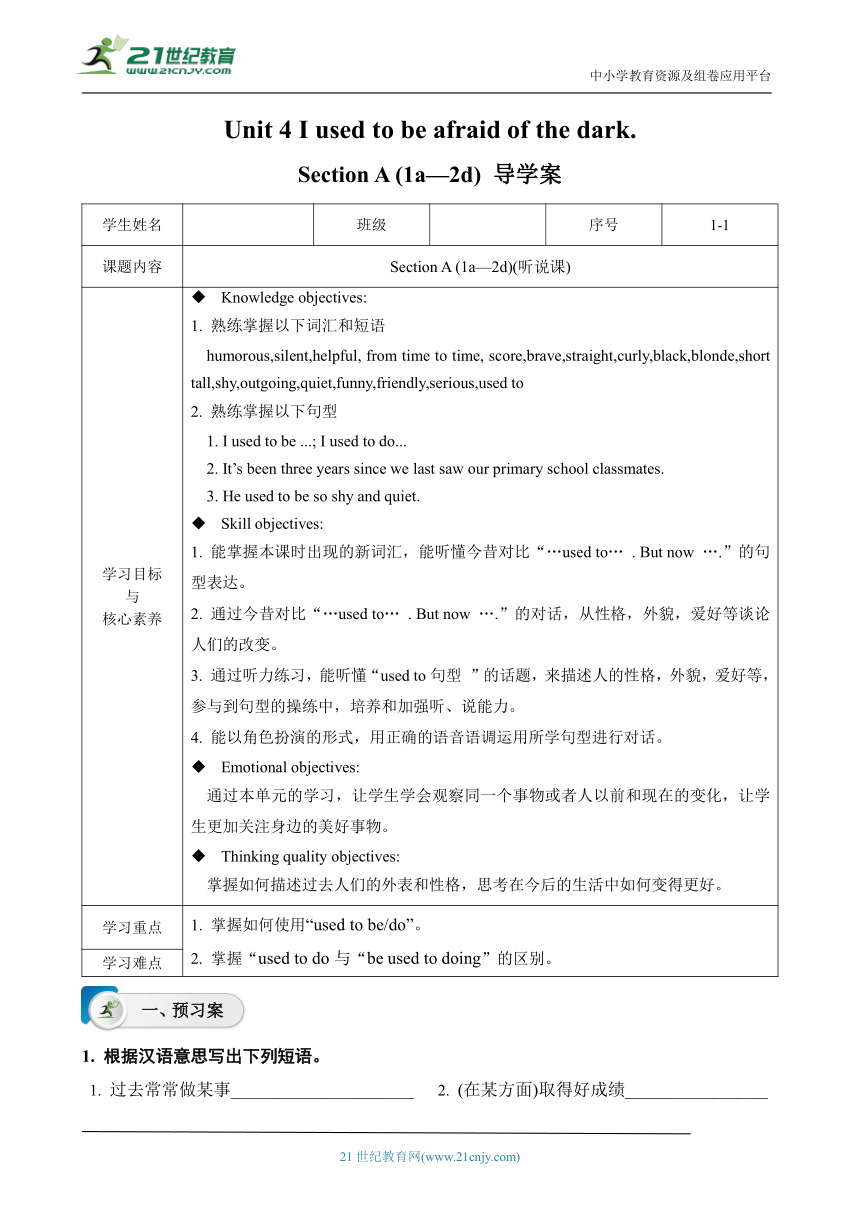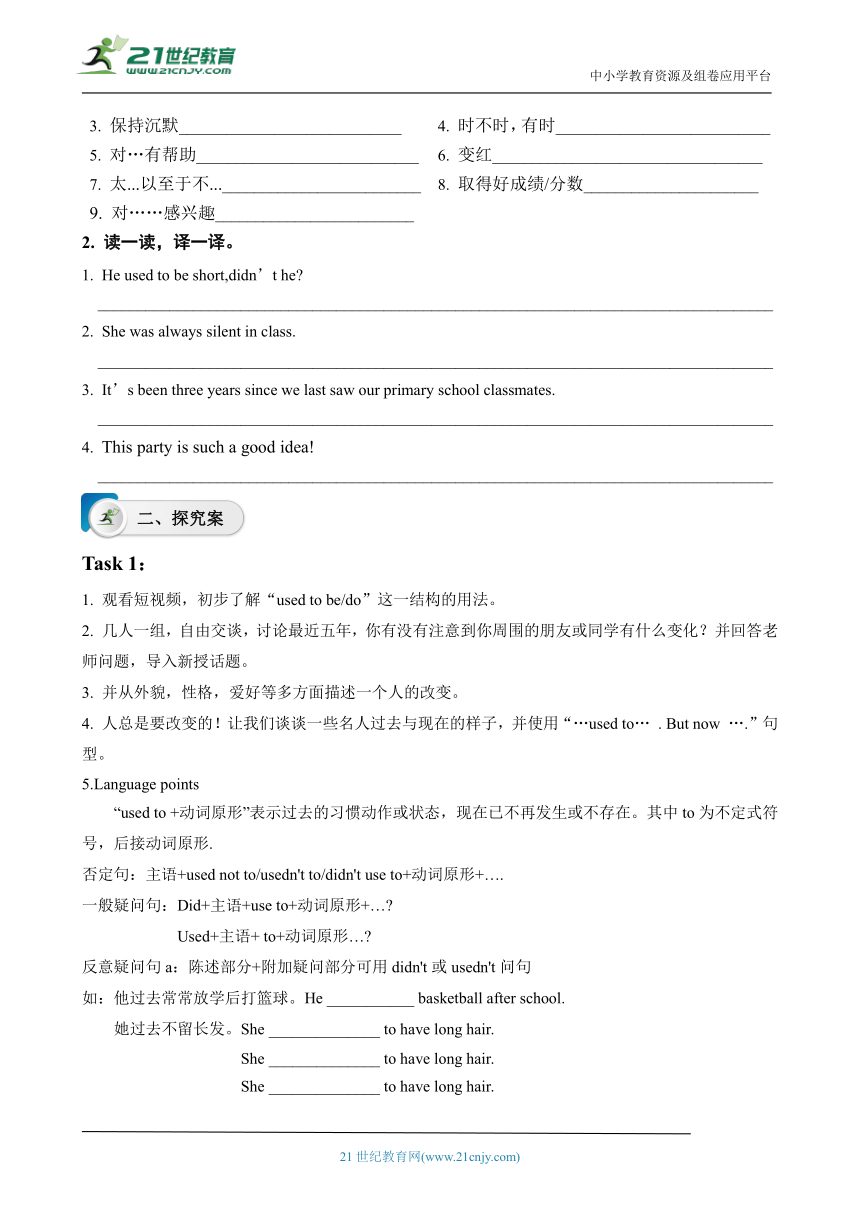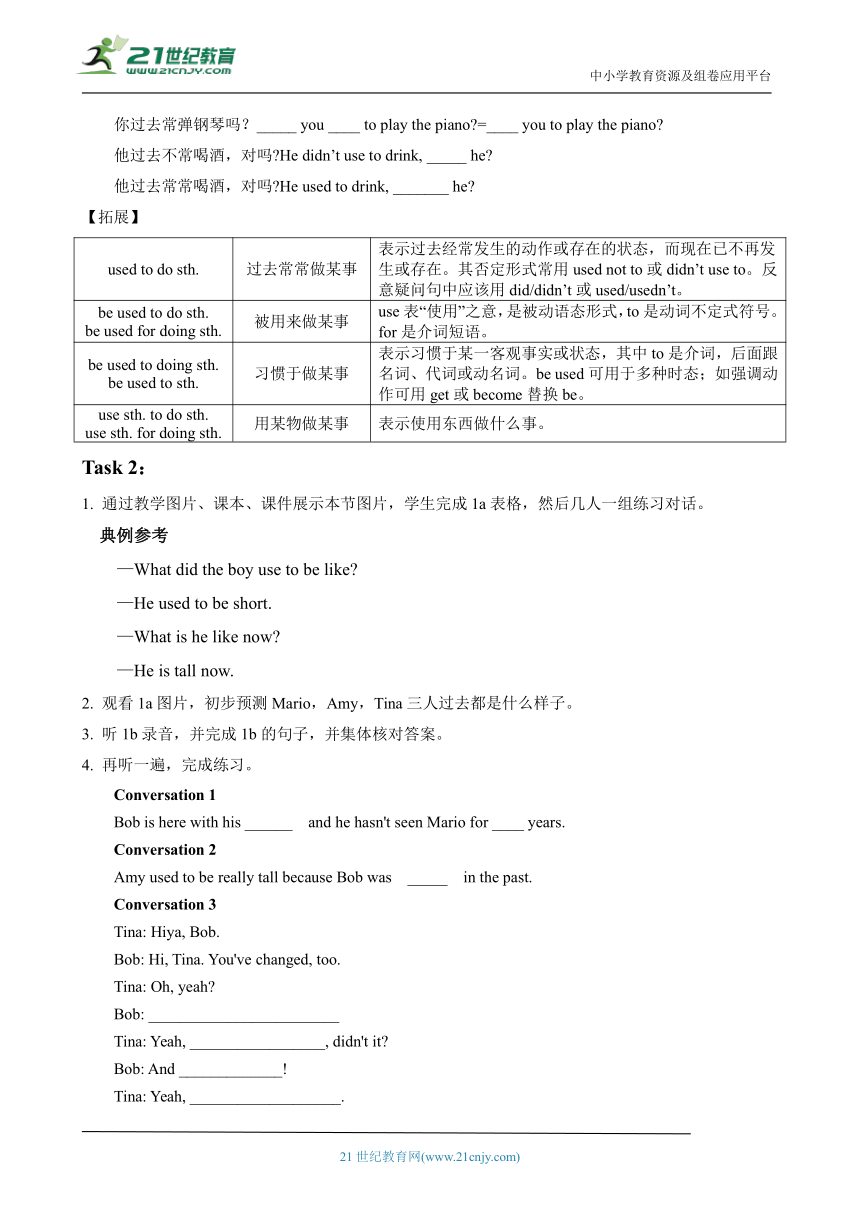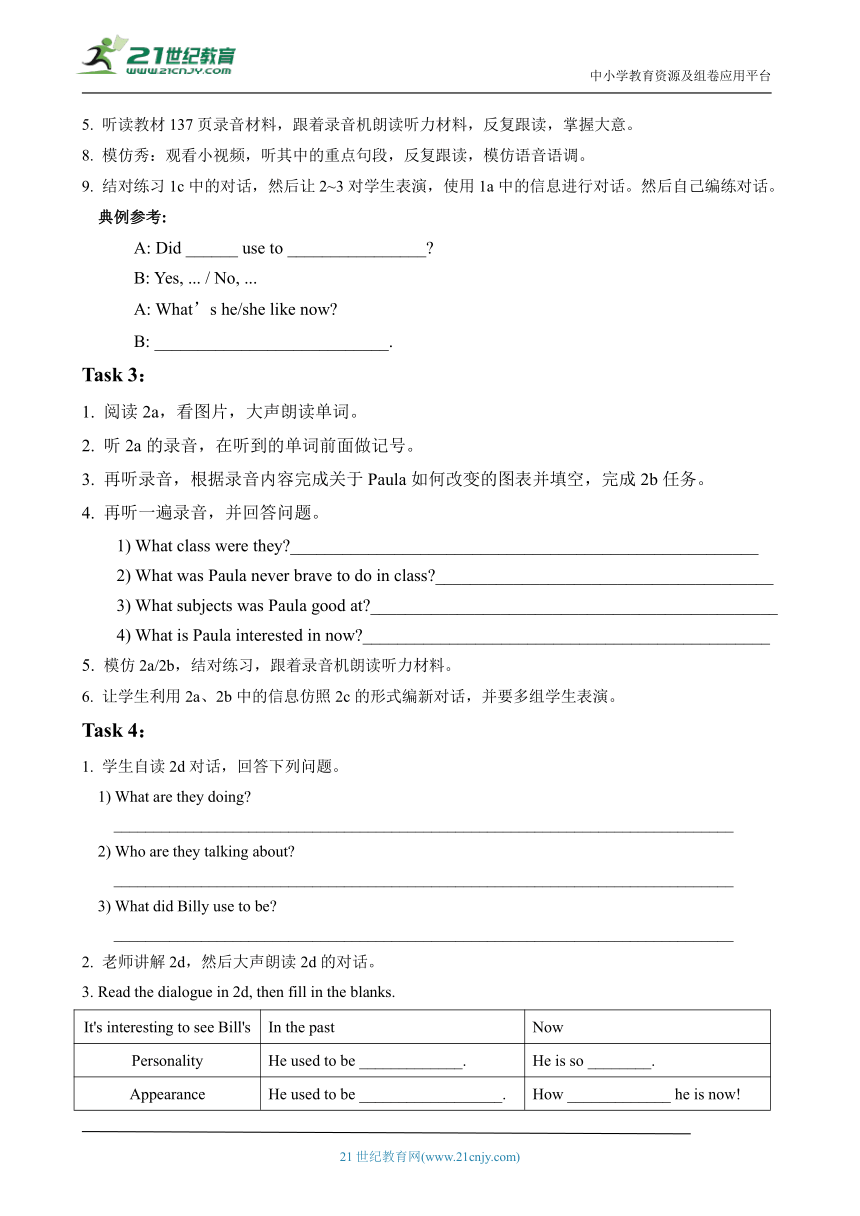【核心素养目标】Unit 4 I used to be afraid of the dark Section A 1a-2d 导学案(含答案)
文档属性
| 名称 | 【核心素养目标】Unit 4 I used to be afraid of the dark Section A 1a-2d 导学案(含答案) |

|
|
| 格式 | docx | ||
| 文件大小 | 1.4MB | ||
| 资源类型 | 试卷 | ||
| 版本资源 | 人教新目标(Go for it)版 | ||
| 科目 | 英语 | ||
| 更新时间 | 2022-09-29 16:40:06 | ||
图片预览




文档简介
中小学教育资源及组卷应用平台
Unit 4 I used to be afraid of the dark.
Section A (1a—2d) 导学案
学生姓名 班级 序号 1-1
课题内容 Section A (1a—2d)(听说课)
学习目标 与 核心素养 Knowledge objectives: 1. 熟练掌握以下词汇和短语 humorous,silent,helpful, from time to time, score,brave,straight,curly,black,blonde,short tall,shy,outgoing,quiet,funny,friendly,serious,used to 2. 熟练掌握以下句型 1. I used to be ...; I used to do... 2. It’s been three years since we last saw our primary school classmates. 3. He used to be so shy and quiet. Skill objectives: 1. 能掌握本课时出现的新词汇,能听懂今昔对比“…used to… . But now ….”的句型表达。 2. 通过今昔对比“…used to… . But now ….”的对话,从性格,外貌,爱好等谈论人们的改变。 3. 通过听力练习,能听懂“used to句型 ”的话题,来描述人的性格,外貌,爱好等,参与到句型的操练中,培养和加强听、说能力。 4. 能以角色扮演的形式,用正确的语音语调运用所学句型进行对话。 Emotional objectives: 通过本单元的学习,让学生学会观察同一个事物或者人以前和现在的变化,让学生更加关注身边的美好事物。 Thinking quality objectives: 掌握如何描述过去人们的外表和性格,思考在今后的生活中如何变得更好。
学习重点 掌握如何使用“used to be/do”。 掌握“used to do与“be used to doing”的区别。
学习难点
1. 根据汉语意思写出下列短语。
过去常常做某事_______________________ (在某方面)取得好成绩__________________
保持沉默____________________________ 时不时,有时___________________________
对…有帮助____________________________ 变红__________________________________
太...以至于不..._________________________ 取得好成绩/分数______________________
对……感兴趣_________________________
读一读,译一译。
He used to be short,didn’t he
_____________________________________________________________________________________
She was always silent in class.
_____________________________________________________________________________________
It’s been three years since we last saw our primary school classmates.
_____________________________________________________________________________________
This party is such a good idea!
_____________________________________________________________________________________
Task 1:
1. 观看短视频,初步了解“used to be/do”这一结构的用法。
2. 几人一组,自由交谈,讨论最近五年,你有没有注意到你周围的朋友或同学有什么变化?并回答老师问题,导入新授话题。
3. 并从外貌,性格,爱好等多方面描述一个人的改变。
4. 人总是要改变的!让我们谈谈一些名人过去与现在的样子,并使用“…used to… . But now ….”句型。
5.Language points
“used to +动词原形”表示过去的习惯动作或状态,现在已不再发生或不存在。其中to为不定式符号,后接动词原形.
否定句:主语+used not to/usedn't to/didn't use to+动词原形+….
一般疑问句:Did+主语+use to+动词原形+…
Used+主语+ to+动词原形…
反意疑问句a:陈述部分+附加疑问部分可用didn't或usedn't问句
如:他过去常常放学后打篮球。He ___________ basketball after school.
她过去不留长发。She ______________ to have long hair.
She ______________ to have long hair.
She ______________ to have long hair.
你过去常弹钢琴吗?_____ you ____ to play the piano =____ you to play the piano
他过去不常喝酒,对吗 He didn’t use to drink, _____ he
他过去常常喝酒,对吗 He used to drink, _______ he
【拓展】
used to do sth. 过去常常做某事 表示过去经常发生的动作或存在的状态,而现在已不再发生或存在。其否定形式常用used not to或didn’t use to。反意疑问句中应该用did/didn’t或used/usedn’t。
be used to do sth. be used for doing sth. 被用来做某事 use表“使用”之意,是被动语态形式,to是动词不定式符号。for是介词短语。
be used to doing sth. be used to sth. 习惯于做某事 表示习惯于某一客观事实或状态,其中to是介词,后面跟名词、代词或动名词。be used可用于多种时态;如强调动作可用get或become替换be。
use sth. to do sth. use sth. for doing sth. 用某物做某事 表示使用东西做什么事。
Task 2:
1. 通过教学图片、课本、课件展示本节图片,学生完成1a表格,然后几人一组练习对话。
典例参考
—What did the boy use to be like
—He used to be short.
—What is he like now
—He is tall now.
2. 观看1a图片,初步预测Mario,Amy,Tina三人过去都是什么样子。
3. 听1b录音,并完成1b的句子,并集体核对答案。
4. 再听一遍,完成练习。
Conversation 1
Bob is here with his ______ and he hasn't seen Mario for ____ years.
Conversation 2
Amy used to be really tall because Bob was _____ in the past.
Conversation 3
Tina: Hiya, Bob.
Bob: Hi, Tina. You've changed, too.
Tina: Oh, yeah
Bob: ________________________
Tina: Yeah, _________________, didn't it
Bob: And _____________!
Tina: Yeah, ___________________.
5. 听读教材137页录音材料,跟着录音机朗读听力材料,反复跟读,掌握大意。
8. 模仿秀:观看小视频,听其中的重点句段,反复跟读,模仿语音语调。
9. 结对练习1c中的对话,然后让2~3对学生表演,使用1a中的信息进行对话。然后自己编练对话。
典例参考:
A: Did ______ use to ________________
B: Yes, ... / No, ...
A: What’s he/she like now
B: ___________________________.
Task 3:
1. 阅读2a,看图片,大声朗读单词。
2. 听2a的录音,在听到的单词前面做记号。
3. 再听录音,根据录音内容完成关于Paula如何改变的图表并填空,完成2b任务。
4. 再听一遍录音,并回答问题。
1) What class were they ______________________________________________________
2) What was Paula never brave to do in class _______________________________________
3) What subjects was Paula good at _______________________________________________
4) What is Paula interested in now _______________________________________________
5. 模仿2a/2b,结对练习,跟着录音机朗读听力材料。
6. 让学生利用2a、2b中的信息仿照2c的形式编新对话,并要多组学生表演。
Task 4:
1. 学生自读2d对话,回答下列问题。
1) What are they doing
______________________________________________________________________________
2) Who are they talking about
______________________________________________________________________________
3) What did Billy use to be
______________________________________________________________________________
2. 老师讲解2d,然后大声朗读2d的对话。
3. Read the dialogue in 2d, then fill in the blanks.
It's interesting to see Bill's In the past Now
Personality He used to be _____________. He is so ________.
Appearance He used to be __________________. How _____________ he is now!
Everyday actions He used to ______ in the library. /
Talk to girls His face used to _________ when he talked to girl. All the girls are ____________.
4. 模仿秀:观看小视频(2d),听其中的重点句段,反复跟读,模仿语音语调。
5. 两人一组读2d的对话,然后让2-3对学生分角色表演对话。
6. 家庭作业。
1)Do the exercises in students’ book.
2)Practice the conversation on Page 26, 2d.
3)Preview the passage in 3a.
Ⅰ. 根据句意及汉语提示完成单词。
His brother is a ____________(有幽默感的) person.
Sorry I can't be more ____________(有帮助的).
He is a ____________(严肃的) man; he doesn't like to smile.
She wants to get good ____________(分数) in the test.
Bob used to be ____________(沉默的) in class.
Ⅱ. 用所给词的正确形式填空。
____________(do) you use to swim in this river
There's always a ____________(friend) smile on her face.
Eliza used to ____________(read) newspapers after supper.
He is afraid of ____________(make) a speech in front of so many people.
It is relaxing ____________(talk) to others when you are free.
Ⅲ. 单项选择。
He used to be short, ________?
A. didn't she B. didn't he C. doesn't he D. doesn't she
I ________ a lot but I don't play very often now.
A. used to play basketball B. was used to play basketball
C. am used to play basketball D. was used to playing basketball
It is ________ bad weather that we will change our plan.
A. such B. so C. such a D. so a
It's boring ________ at home on weekends.
A. stay B. stays C. staying D. to stay
He doesn't do his homework ________. So he always makes some mistakes.
A. careful enough B. enough careful
C. carefully enough D. enough carefully
Ⅳ. 完成句子。
那是一本如此有用的书。
That is ________ ________ ________ ________.
自从我离开家乡已经十年了。
It's ten years ________ I ________ my hometown.
他过去时常在家里弹钢琴。
He used to play the piano ________ ________ ________ ________ at home.
现在他对打篮球更感兴趣。
Now he is more ________ ________playing basketball.
她如此受欢迎以至于所有学生都围着她转。
She is so popular that all the students are ________ ________.
预习案答案
1. 根据汉语意思写出下列短语。
used to do sth. get good grades (in sth.) keep silent
from time to time be helpful to sb. turn red
never/not...enough to... get good scores be interested in
2. 读一读,译一译。
略
探究案答案
Task 1:
5.Language points
used to play;didn’t use/usedn’t/used not; Did;use/Used; did;usedn’t
Task 2:
4. 再听一遍,完成练习。
Conversation 1:parents;four
Conversation 2:short
Conversation 3:You have blonde hair!;it used to be red;it's straight;it used to be curly
Task 3:
4. 再听一遍录音,并回答问题。
1) They were in the same science class.
2) She was never brave to ask questions to teachers.
3) Science and music.
4) Paula is more interested in sports now.
Task 4:
1. 学生自读2d对话,回答下列问题。
1) They are having a party.
2) They are talking about Billy.
3) He used to be shy, quiet and thin.
3. Read the dialogue in 2d, then fill in the blanks.
shy and quiet;popular;thin and wear glasses;big and strong;read;turn red;around him
训练案答案
Ⅰ. 根据句意及汉语提示完成单词。
humorous helpful serious scores/grades silent
Ⅱ. 用所给词的正确形式填空。
Did friendly read making to talk
Ⅲ. 单项选择。
B A A D C
Ⅳ. 完成句子。
such a useful book/so useful a book since; left from time to time
interested in around her
21世纪教育网 www.21cnjy.com 精品试卷·第 2 页 (共 2 页)
21世纪教育网(www.21cnjy.com)
Unit 4 I used to be afraid of the dark.
Section A (1a—2d) 导学案
学生姓名 班级 序号 1-1
课题内容 Section A (1a—2d)(听说课)
学习目标 与 核心素养 Knowledge objectives: 1. 熟练掌握以下词汇和短语 humorous,silent,helpful, from time to time, score,brave,straight,curly,black,blonde,short tall,shy,outgoing,quiet,funny,friendly,serious,used to 2. 熟练掌握以下句型 1. I used to be ...; I used to do... 2. It’s been three years since we last saw our primary school classmates. 3. He used to be so shy and quiet. Skill objectives: 1. 能掌握本课时出现的新词汇,能听懂今昔对比“…used to… . But now ….”的句型表达。 2. 通过今昔对比“…used to… . But now ….”的对话,从性格,外貌,爱好等谈论人们的改变。 3. 通过听力练习,能听懂“used to句型 ”的话题,来描述人的性格,外貌,爱好等,参与到句型的操练中,培养和加强听、说能力。 4. 能以角色扮演的形式,用正确的语音语调运用所学句型进行对话。 Emotional objectives: 通过本单元的学习,让学生学会观察同一个事物或者人以前和现在的变化,让学生更加关注身边的美好事物。 Thinking quality objectives: 掌握如何描述过去人们的外表和性格,思考在今后的生活中如何变得更好。
学习重点 掌握如何使用“used to be/do”。 掌握“used to do与“be used to doing”的区别。
学习难点
1. 根据汉语意思写出下列短语。
过去常常做某事_______________________ (在某方面)取得好成绩__________________
保持沉默____________________________ 时不时,有时___________________________
对…有帮助____________________________ 变红__________________________________
太...以至于不..._________________________ 取得好成绩/分数______________________
对……感兴趣_________________________
读一读,译一译。
He used to be short,didn’t he
_____________________________________________________________________________________
She was always silent in class.
_____________________________________________________________________________________
It’s been three years since we last saw our primary school classmates.
_____________________________________________________________________________________
This party is such a good idea!
_____________________________________________________________________________________
Task 1:
1. 观看短视频,初步了解“used to be/do”这一结构的用法。
2. 几人一组,自由交谈,讨论最近五年,你有没有注意到你周围的朋友或同学有什么变化?并回答老师问题,导入新授话题。
3. 并从外貌,性格,爱好等多方面描述一个人的改变。
4. 人总是要改变的!让我们谈谈一些名人过去与现在的样子,并使用“…used to… . But now ….”句型。
5.Language points
“used to +动词原形”表示过去的习惯动作或状态,现在已不再发生或不存在。其中to为不定式符号,后接动词原形.
否定句:主语+used not to/usedn't to/didn't use to+动词原形+….
一般疑问句:Did+主语+use to+动词原形+…
Used+主语+ to+动词原形…
反意疑问句a:陈述部分+附加疑问部分可用didn't或usedn't问句
如:他过去常常放学后打篮球。He ___________ basketball after school.
她过去不留长发。She ______________ to have long hair.
She ______________ to have long hair.
She ______________ to have long hair.
你过去常弹钢琴吗?_____ you ____ to play the piano =____ you to play the piano
他过去不常喝酒,对吗 He didn’t use to drink, _____ he
他过去常常喝酒,对吗 He used to drink, _______ he
【拓展】
used to do sth. 过去常常做某事 表示过去经常发生的动作或存在的状态,而现在已不再发生或存在。其否定形式常用used not to或didn’t use to。反意疑问句中应该用did/didn’t或used/usedn’t。
be used to do sth. be used for doing sth. 被用来做某事 use表“使用”之意,是被动语态形式,to是动词不定式符号。for是介词短语。
be used to doing sth. be used to sth. 习惯于做某事 表示习惯于某一客观事实或状态,其中to是介词,后面跟名词、代词或动名词。be used可用于多种时态;如强调动作可用get或become替换be。
use sth. to do sth. use sth. for doing sth. 用某物做某事 表示使用东西做什么事。
Task 2:
1. 通过教学图片、课本、课件展示本节图片,学生完成1a表格,然后几人一组练习对话。
典例参考
—What did the boy use to be like
—He used to be short.
—What is he like now
—He is tall now.
2. 观看1a图片,初步预测Mario,Amy,Tina三人过去都是什么样子。
3. 听1b录音,并完成1b的句子,并集体核对答案。
4. 再听一遍,完成练习。
Conversation 1
Bob is here with his ______ and he hasn't seen Mario for ____ years.
Conversation 2
Amy used to be really tall because Bob was _____ in the past.
Conversation 3
Tina: Hiya, Bob.
Bob: Hi, Tina. You've changed, too.
Tina: Oh, yeah
Bob: ________________________
Tina: Yeah, _________________, didn't it
Bob: And _____________!
Tina: Yeah, ___________________.
5. 听读教材137页录音材料,跟着录音机朗读听力材料,反复跟读,掌握大意。
8. 模仿秀:观看小视频,听其中的重点句段,反复跟读,模仿语音语调。
9. 结对练习1c中的对话,然后让2~3对学生表演,使用1a中的信息进行对话。然后自己编练对话。
典例参考:
A: Did ______ use to ________________
B: Yes, ... / No, ...
A: What’s he/she like now
B: ___________________________.
Task 3:
1. 阅读2a,看图片,大声朗读单词。
2. 听2a的录音,在听到的单词前面做记号。
3. 再听录音,根据录音内容完成关于Paula如何改变的图表并填空,完成2b任务。
4. 再听一遍录音,并回答问题。
1) What class were they ______________________________________________________
2) What was Paula never brave to do in class _______________________________________
3) What subjects was Paula good at _______________________________________________
4) What is Paula interested in now _______________________________________________
5. 模仿2a/2b,结对练习,跟着录音机朗读听力材料。
6. 让学生利用2a、2b中的信息仿照2c的形式编新对话,并要多组学生表演。
Task 4:
1. 学生自读2d对话,回答下列问题。
1) What are they doing
______________________________________________________________________________
2) Who are they talking about
______________________________________________________________________________
3) What did Billy use to be
______________________________________________________________________________
2. 老师讲解2d,然后大声朗读2d的对话。
3. Read the dialogue in 2d, then fill in the blanks.
It's interesting to see Bill's In the past Now
Personality He used to be _____________. He is so ________.
Appearance He used to be __________________. How _____________ he is now!
Everyday actions He used to ______ in the library. /
Talk to girls His face used to _________ when he talked to girl. All the girls are ____________.
4. 模仿秀:观看小视频(2d),听其中的重点句段,反复跟读,模仿语音语调。
5. 两人一组读2d的对话,然后让2-3对学生分角色表演对话。
6. 家庭作业。
1)Do the exercises in students’ book.
2)Practice the conversation on Page 26, 2d.
3)Preview the passage in 3a.
Ⅰ. 根据句意及汉语提示完成单词。
His brother is a ____________(有幽默感的) person.
Sorry I can't be more ____________(有帮助的).
He is a ____________(严肃的) man; he doesn't like to smile.
She wants to get good ____________(分数) in the test.
Bob used to be ____________(沉默的) in class.
Ⅱ. 用所给词的正确形式填空。
____________(do) you use to swim in this river
There's always a ____________(friend) smile on her face.
Eliza used to ____________(read) newspapers after supper.
He is afraid of ____________(make) a speech in front of so many people.
It is relaxing ____________(talk) to others when you are free.
Ⅲ. 单项选择。
He used to be short, ________?
A. didn't she B. didn't he C. doesn't he D. doesn't she
I ________ a lot but I don't play very often now.
A. used to play basketball B. was used to play basketball
C. am used to play basketball D. was used to playing basketball
It is ________ bad weather that we will change our plan.
A. such B. so C. such a D. so a
It's boring ________ at home on weekends.
A. stay B. stays C. staying D. to stay
He doesn't do his homework ________. So he always makes some mistakes.
A. careful enough B. enough careful
C. carefully enough D. enough carefully
Ⅳ. 完成句子。
那是一本如此有用的书。
That is ________ ________ ________ ________.
自从我离开家乡已经十年了。
It's ten years ________ I ________ my hometown.
他过去时常在家里弹钢琴。
He used to play the piano ________ ________ ________ ________ at home.
现在他对打篮球更感兴趣。
Now he is more ________ ________playing basketball.
她如此受欢迎以至于所有学生都围着她转。
She is so popular that all the students are ________ ________.
预习案答案
1. 根据汉语意思写出下列短语。
used to do sth. get good grades (in sth.) keep silent
from time to time be helpful to sb. turn red
never/not...enough to... get good scores be interested in
2. 读一读,译一译。
略
探究案答案
Task 1:
5.Language points
used to play;didn’t use/usedn’t/used not; Did;use/Used; did;usedn’t
Task 2:
4. 再听一遍,完成练习。
Conversation 1:parents;four
Conversation 2:short
Conversation 3:You have blonde hair!;it used to be red;it's straight;it used to be curly
Task 3:
4. 再听一遍录音,并回答问题。
1) They were in the same science class.
2) She was never brave to ask questions to teachers.
3) Science and music.
4) Paula is more interested in sports now.
Task 4:
1. 学生自读2d对话,回答下列问题。
1) They are having a party.
2) They are talking about Billy.
3) He used to be shy, quiet and thin.
3. Read the dialogue in 2d, then fill in the blanks.
shy and quiet;popular;thin and wear glasses;big and strong;read;turn red;around him
训练案答案
Ⅰ. 根据句意及汉语提示完成单词。
humorous helpful serious scores/grades silent
Ⅱ. 用所给词的正确形式填空。
Did friendly read making to talk
Ⅲ. 单项选择。
B A A D C
Ⅳ. 完成句子。
such a useful book/so useful a book since; left from time to time
interested in around her
21世纪教育网 www.21cnjy.com 精品试卷·第 2 页 (共 2 页)
21世纪教育网(www.21cnjy.com)
同课章节目录
- Unit 1 How can we become good learners.
- Section A
- Section B
- Unit 2 I think that mooncakes are delicious!
- Section A
- Section B
- Unit 3 Could you please tell me where the restroom
- Section A
- Section B
- Unit 4 I used to be afraid of the dark.
- Section A
- Section B
- Unit 5 What are the shirts made of?
- Section A
- Section B
- Review of Units 1-5
- Unit 6 When was it invented?
- Section A
- Section B
- Unit 7 Teenagers should be allowed to choose their
- Section A
- Section B
- Unit 8 It must belong to Carla.
- Section A
- Section B
- Unit 9 I like music that I can dance to.
- Section A
- Section B
- Unit 10 You're supposed to shake hands.
- Section A
- Section B
- Review of Units 6-10
- Unit 11 Sad movies make me cry.
- Section A
- Section B
- Unit 12 Life is full of the unexpected
- Section A
- Section B
- Unit 13 We're trying to save the earth!
- Section A
- Section B
- Unit 14 I remember meeting all of you in Grade 7.
- Section A
- Section B
- Review of Units 11-14
